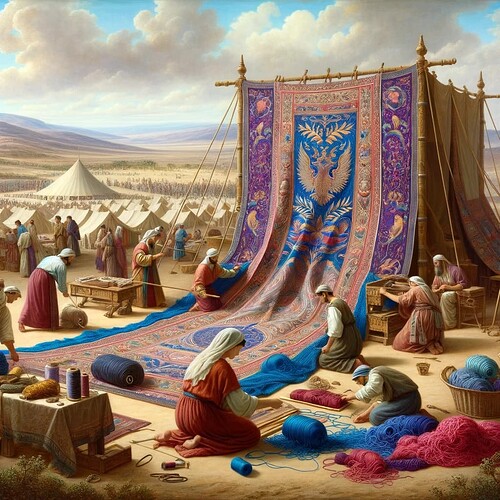![]() February 15: Exodus 26 - Designing Divine Dwellings
February 15: Exodus 26 - Designing Divine Dwellings
Introduction:
![]() Today we step into the divine architect’s world as we delve into Exodus 26. Here, we encounter God’s intricate instructions to Moses on setting up a sanctuary, a physical representation of God’s presence among His people.
Today we step into the divine architect’s world as we delve into Exodus 26. Here, we encounter God’s intricate instructions to Moses on setting up a sanctuary, a physical representation of God’s presence among His people.
![]() God Describes the Tabernacle:
God Describes the Tabernacle:
Exodus 26 offers us intricate details about the construction of God’s tabernacle. Here, we delve into the grand design, from the ten splendid curtains sewn together, their colors and fashioning, to the structure of the tabernacle itself – covered by cautiously arranged layers of linen, goat hair, ram skin, and sea cow skin.
![]() Key Verse: Exodus 26:30 - “Set up the tabernacle according to the plan shown to you on the mountain.”
Key Verse: Exodus 26:30 - “Set up the tabernacle according to the plan shown to you on the mountain.”
![]() Key Themes and Reflections:
Key Themes and Reflections:
- Divine guidance: God doesn’t leave us clueless. Just as He provided Moses with exact measurements and detailed instructions, He directs our lives today.
- God’s presence: The instructions for this earthly dwelling signify God’s desire to dwell amidst His people. God seeks a relationship with us, a concept as relevant today as it was in Moses’ time.
![]() Today’s Application:
Today’s Application:
In our own lives, we are the temple which God wants to make His dwelling (1 Co 3:16). As we walk in obedience and reverence to Him, we make our hearts a suitable dwelling for His spirit.
![]() Hidden Gem:
Hidden Gem:
Have you ever noticed how the numbers in Exodus 26 (10, 20, 30, 50) could signify order and completion? The numerology often carries symbolic meaning in biblical texts.
![]() Reflective Q&A:
Reflective Q&A:
![]() Why did God provide such detailed instructions for the construction of the tabernacle?
Why did God provide such detailed instructions for the construction of the tabernacle?
A: It underscores His desire for perfection and sanctity in spaces of worship. God didn’t leave anything to human assumption or cultural influence.
![]() What does Exodus 26 teach us about Divine inspiration?
What does Exodus 26 teach us about Divine inspiration?
A: The divine blueprint for the tabernacle shows that God inspires and instructs in minute detail when we are on mission for Him.
![]() How can I make my heart a suitable dwelling for God today?
How can I make my heart a suitable dwelling for God today?
A: By constant obedience, repentance of sin, serving others, and maintaining an intimate relationship with Him.
![]() Join the Discussion:
Join the Discussion:
How does knowing that God wants to dwell with us transform your understanding of your relationship with Him?
![]() See You Tomorrow in Exodus 27:
See You Tomorrow in Exodus 27:
We’ll explore the altars and courtyards as we delve deeper into the architecture of faith.
Remember: God yearns for a dwelling among us because He loves us and desires a relationship with us. Reflect on what that means for you today, and see you tomorrow!
